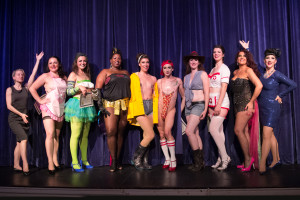
How did you get your start in Burlesque?
I got into burlesque thanks in part to my mom. I had been to maybe one or two burlesque shows but never thought about participating. My mom told me about a segment she saw about the Academy of Burlesque and the Burlesque 101 classes on a local television show. I was intrigued and looked into it. It looked like it would be a hoot so I signed up. I hadn’t made plans to continue performing after the recital. I figured I had my moment in the burlesque spotlight and that was it but a friend of a friend was putting on a show and was looking for burlesque performers. My career snowballed from there.
How long have you been performing?
My eight year burlesque anniversary was this past August.
What has been the best single piece of advice about performing that you have received?
In a class in the Burlesque 101 course Miss Indigo Blue said your performance should always tell a story. That really struck a chord with me and I pretty much live by those words. I’m always thinking of what am I trying to say or what story am I trying to tell when I create an act.
What drew you to Burlesque?
It looked like so much fun and I loved the idea of creating acts and putting it all together from what story I want to tell to finding music that can encompass story telling to choreography.
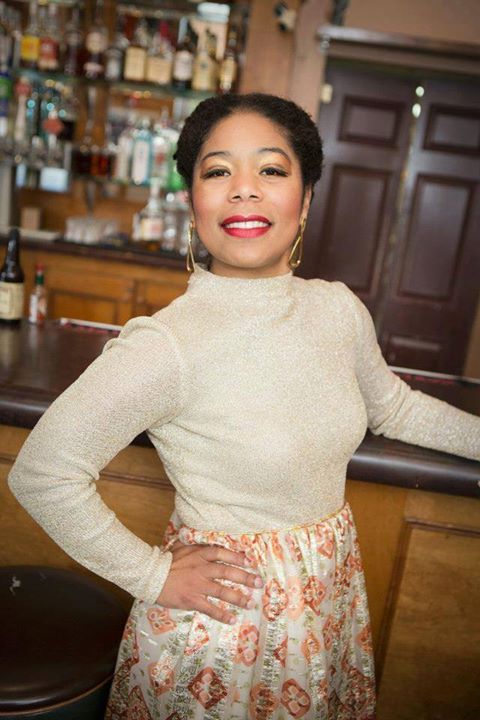
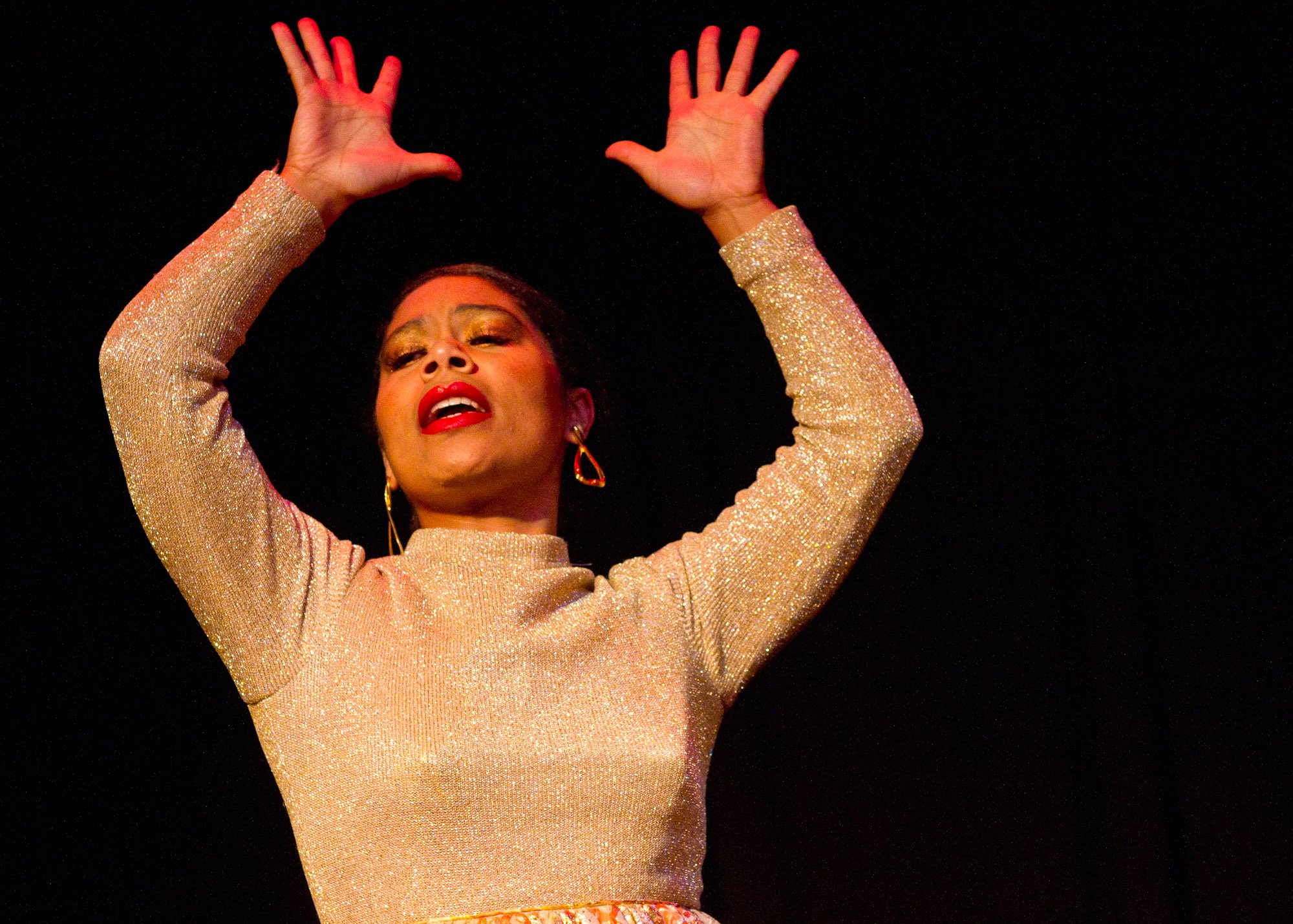
Were you always a performer?
I sporadically took dance classes throughout my life but never had a solid string of years where I had a disciplined practice. I never had a problem in front of people or on stage. I always found it fun to perform and entertain.
Any pre-performance rituals?
I always have to practice my routine a few times back stage. Even if I’ve done the routine a thousand times and can do it in my sleep. Going through the routine helps calms my nerves and gives me the okay, like, you know your stuff, go out there and kill it.
In what ways is Burlesque inherently political?
The root of the word burlesque is derived from the Italian word burla which means to joke, ridicule, or mock. Even if the basis is comedic it is still using an emotion to tell a story, to create a dialog or use commentary to highlight a specific issue. Being a woman on stage in a patriarchal society is political in of itself not to mention being a person of color, or someone with a disability, or someone from the LGBTQ community. People from marginalized groups getting onstage and creating art for themselves and others is extremely political.
What do you want people to take away from your class?
What I want people to take away from the class is the confidence and steps to create an act that not only speaks about something that is important to you but is also socially conscious.
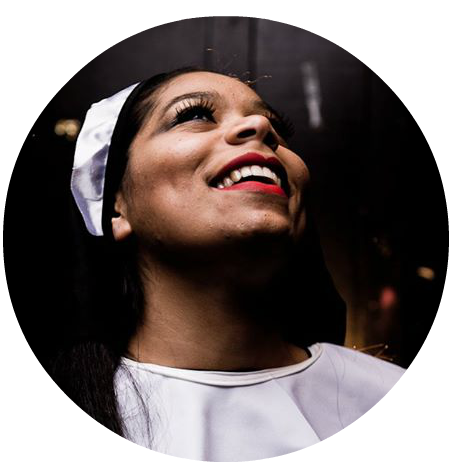
The post A Minute with Chesty LaRue appeared first on Academy of Burlesque.
]]>
Yeah. I have done a lot of different types of dance. I came to dance late so I felt like I needed to get my hands into anything I could when I first started.
When did you start?
I started training in 2001 in my senior year of high school. A lot of dancers start when they are three years old in ballet class. That wasn’t my story, I actually became an athlete at a very young age and was talked out of being a dancer and then eventually came back to it because of my passion.
What kind of athlete were you?
I was a runner. I was a runner from age 8-17. I ran track. I traveled the country with two different age group track teams and it was a very big part of my childhood.
What brought you back to dance?
I decided to do a play in high school and I told my parents that I was going to audition. They didn’t know what to expect. All of us kids were athletes and they didn’t have any children that were artists. So I auditioned for a play. My high school had an amazing theater program and so it was a big deal to be in a production in my school. I auditioned and I got a secondary lead and it was a drama which subsequently lead me to be in the spring musical Dream Girls. I was in the chorus of that show and that really sparked my passion for being on stage.
What lead you to burlesque?
Burlesque was something that I knew about. I knew about the resurgence when I lived in Philadelphia, but I didn’t know how to really get into it. I was in the same dance company as Sophie Sucre of Peek-A-Boo Revue and I knew that she did burlesque, but really didn’t know how I could hop into that. So after I finished Grad School I took some cabaret classes at Debbie Reynold’s studio and just really loved being around people celebrating their bodies. When I moved to Seattle 4 ½ years ago, I met Miss Briq House and the rest is pretty much history. She at that time was getting ready to have Shuga Shaq for the first time at the Can Can and I started Kittening for her and then eventually had my debut at the Sunday night Shuga Shaq and just went from there.
Did spICE! come with you from the East coast or was she somebody you created here in Seattle?
I think I had been creating her for a long time. I didn’t know how to express or exude that kind of energy in concert dance. Concert dance is a different kind of energy. It’s not entertainment. It’s art for art’s sake. So I didn’t really know how to release that energy. After my debut, I had never felt that liberated on stage. She was in me for a long time and I felt like I had freed her.
Do you have any pre-performance rituals?
Stretching. If I have the space some yoga and jogging. I usually come to the theater in baggy sweat pants and hoodie not dressed all the way for stage. My body needs to be extremely warm and sweaty before I get on stage. I have had that ritual since Grad school.
What has been the best piece of performance art you’ve seen in the last year?
Sydni Devereaux’s Led Zepplin piece she did a the Moisture Festival.
I was recently on stage with Egypt Black Nile (and basically anything she does) but her performance last year for the Viva Las Vegas competition was one of the most spectacular pieces I’ve ever seen in my life.
Kitten n’ Lou. I love CampTacular. I love their well thought out, witty productions.
Where do you get your ideas from?
It depends on various things, but mostly just from walking down the street listening to music. I will listen to a piece for weeks sometimes months and obsess about it and imagine movement motifs. Sometimes I get the piece into my body it’s not how I imagined, but once I like a motif I will take it and improvise.
What are your favorite choreographic tools?
Repetition, repeat with intensity.
ABA format
Sometimes retrograde
I like to mash things together and embellish and take all the different styles of dance I have learned West African, Bollywood, contemporary and mix and mash them together.
Do you have a piece of advice for someone just starting out in Burlesque?
I had the opportunity a couple of weeks ago to offer this to someone and my advice was for them to be themselves. Be true to your art, be true to your aesthetic, be true to what you bring on stage. That doesn’t mean don’t rehearse or warm up, but you must stand for something and be yourself.
The post Introducing spICE! appeared first on Academy of Burlesque.
]]>
Ten things I have learned in my first few months at Miss Indigo Blue’s Academy of Burlesque:
-
First order of business when opening the studio, sweep up the marabou feathers from the last class
-
There is always a chocolate covered treat in the teacher snack drawer
-
Every day is bring your dog to work day (Sombrero, maracas and all!)
-
The students are the best
-
The teachers are the best
-
There will always be a rhinestone stuck to the bottom of my shoe when leaving the studio
-
I love my job
-
Communication is more than key when scheduling and organizing our instructors who are also performers that are highly in demand
-
The recitals that culminate the Burlesque and Boylesque 101 series are so inspiring to watch, and make me proud to be a part of an experience that is transformative for so many people
-
This place is where #funissexy

The post Cookie’s Top Ten List appeared first on Academy of Burlesque.
]]>
Today our Academy interview team sat down with Elsa/ Ernie Von Schmaltz to talk about what it’s like being a women who plays both a male and a female character onstage.
AOB: Do you consider Ernie a Boylesque character? A drag character? What’s the difference between them?
EVS: Yes, I consider him to be both those things. I think there are differences but there’s also a lot of overlap. The differences I see are traditionally drag kings don’t strip and do lip sync. Traditionally Boylesque is the opposite. I strip, do not lip sync, but I also sing and also MC. And I’m also one of very small handful of women in the nation regularly performing a male character who stays male. So if you want to discuss a category, I would choose Boylesque. But I don’t really care about categories a whole lot because there’s so much cross over and so many similar possibilities between the two genres.
AOB: Do you prepare for playing Elsa and Ernie differently (other than the obvious costume and makeup differences)?
EVS: Not really, no. I rehearse physical gesturing and mannerisms for the characters. If I’m speaking or singing, I will warm up my voice. I try to physically embody each character, so that’s my rehearsal. We look different but ultimately I’m preparing the same body to do two different things.
AOB: How would you describe “masculine” vs. “feminine” movement on stage? Do you make a clear distinction between them?
EVS: I think of feminine gestures as being more fluid than masculine ones. The hands create a pretty shape, the body positions accentuate curves. I think about pinup styles and posing when I’m doing feminine movement. Masculine is broader, more perpendicular planes of movement, less curve more edge. Physically taking up more space with the limbs.
But here’s the thing about a character onstage. If I did a “masculine movement” but was dressed as Elsa, I would still consider that feminine. Because we’re in a visual art form and people make a judgment on gender based on what they see, not necessary movement. Movement seals the deal, but visual is how we start. The primary characteristics that audiences base their opinion on ‘what gender is this person’ is based on things like hair, makeup, attire. And you can have both and play with gender in interesting ways by moving in a way the audience wouldn’t expect based on the visual you’re giving them.
In my case, I’ve split it right down the middle pretty evenly with Elsa as the entirely feminine one and Ernie as the entirely masculine one.
AOB: What advice do you have for women interested in creating male or masculine personas in burlesque?
EVS: Do it! Do some research, look at who else is doing what in your area. Go to shows! Shows that feature women who present as men are not as plentiful, so go see the closest thing you can find. If you can’t find the exact thing, go watch drag queen and absorb the idea of cross gendered performance. Go see boylesque. There’s a thousand shades of gender doing performance. Make a person. Go get a wig, put on facial hair, stuff your pants, do what feels right.
Try something to help you decide who your character is. It might be a one-off thing where you try it and it’s not right, or it might turn into your calling, or drive some other agenda in your life. But try it out and see what happens!
The post Interview: Ernie Von Schmaltz appeared first on Academy of Burlesque.
]]>Instructor The One The Only Inga related some wisdom she’s come to regarding 21st Century Burlesque’s Top 50 list, and other awards and accolades in the burlesque world. 21st Century Burlesque picked up the post in their blog, and we’re sharing it with you again, because it’s worth reading!
See the original post here: http://21stcenturyburlesque.com/burlesque-top-50-one-the-only-inga/
I have by no means lived by these words for my entire career. After spending my first 3-4 years experimenting, I started to create acts that I thought would “get me somewhere” … and for a while, they did! But a few more years passed, and I realized that I was no longer inspired by my work, and ultimately unhappy. The spark I used to feel when I was on stage was gone. And to make matters worse, it showed up in my performances: there I was, headlining major festivals in other countries … and completely bombing (if not on the outside, then definitely on the inside) because I just didn’t love what I was putting on stage, and thus I had no love to share with the audience. I was miserable.
I’ve spent the last two years in a bit of a (ok, actually a MAJOR) performer-identity crisis, reevaluating myself and figuring out what makes me feel happy and fulfilled. I’ve changed my name, rethought my character and my overall look and style, and very slowly come to the realization that I’m too much of a weirdo artist to perform work that I don’t adore–I have to feel connected to it, or else I’m unhappy and just don’t perform well.
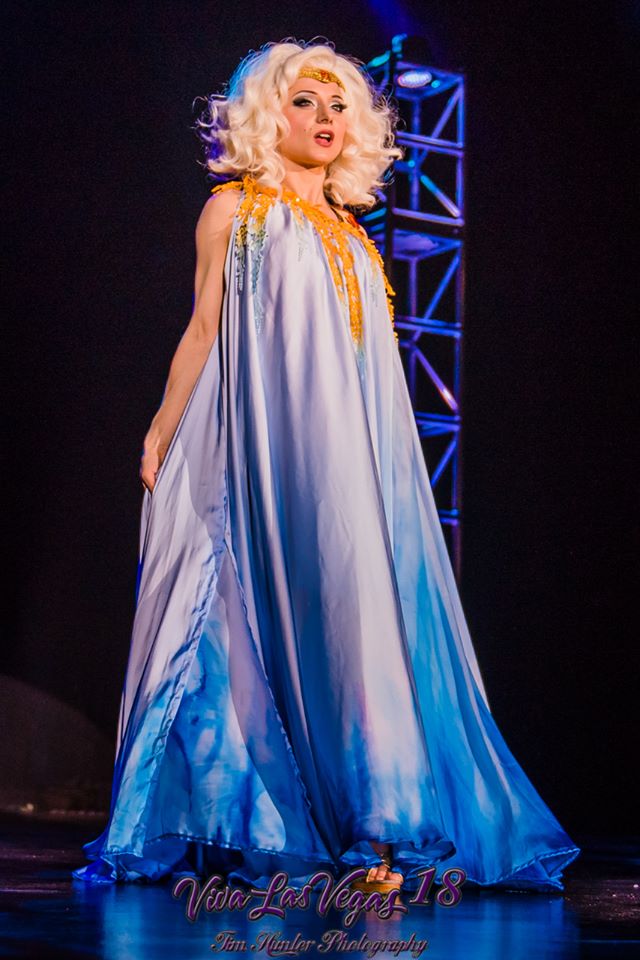
The One and Only Inga in the Viva Las Vegas 2015 burlesque showcase. ©Tim Hunter
When this year’s Burlesque Top 50 came out, I wasn’t expecting to be on it and wasn’t surprised when my name wasn’t there. I haven’t been on the list for a couple years, and I’d laid pretty low in 2015. But there was something different about how I reacted this time around; I didn’t feel as broken or rejected as I had before. In fact, I felt weirdly ok with the whole thing, and couldn’t quite figure out why. Then it dawned on me: I don’t do what I do to get on the list, or win awards, or even headline shows anymore. I do it because I love it. Simple as that. I exhaled as I realized this and it felt as if the cloud of confusion and doubt that had hung over me for so long suddenly dissolved, and I saw myself clearly for the first time in years. It was a beautiful, eye-opening realization that was SO damn obvious, but of course so hard to see when I was struggling.
I wasn’t expecting to be on it and wasn’t surprised when my name wasn’t there … But there was something different about how I reacted this time around; I didn’t feel as broken or rejected as I had before…
A couple of days later I read my friend Sydni Deveraux’s FB post about recognition vs results in burlesque; her words really hit home for me. I saw how many others were affected by her message and seemed to be struggling with the same issues I was. I decided to get over my usual shyness and share the knowledge that had helped me so much. Even if no one read it, it would feel good to put it out there.
The response so far has been overwhelming, and I’ve received messages of gratitude and love from people within the burlesque community and outside of it. I’m a little astounded by the whole thing. But maybe this is a sign that our little stripper world needs to hear messages like this more often–reminders that we are all, first and foremost, artists. And that our artist souls need to be driven by passion and love, not titles or awards.
I’m still figuring out what “loving burlesque” means to me, how I want to display that on stage, and who I am as a performer. I suppose that’s what being an artist is all about, right?
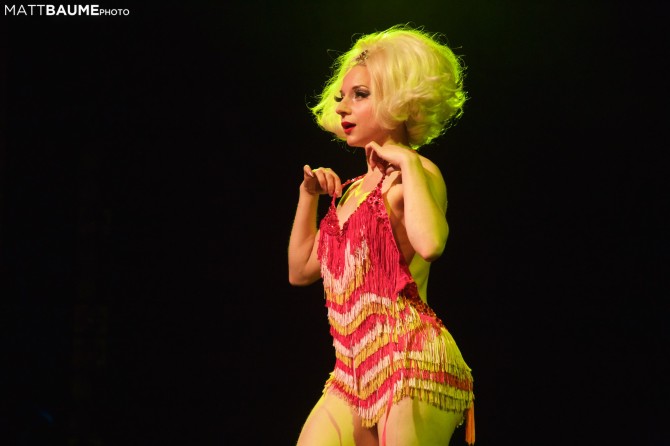
The One and Only Inga in CAKE! A Decade of Decadent Dazzle. ©Matt Baume
I rarely ever share personal feelings or sentiments on social media–mostly because, though I am a professional naked lady, I’m also a very private, shy person … I open up on stage, to my amazing wife, and to my closest friends. And that’s about it. I’ve been this way my whole life. I have no problem with anyone else sharing or speaking out online, it’s just not what I do.
That said, I felt so inspired by Sydni Deveraux’s lovely post yesterday about recognition vs. results in the life of a performer, that I’m actually going to say something about this topic. So here it is:
Perhaps I’m stating the obvious, but being an artist is fucking hard. You are always working, always struggling … even when you seem “successful” in the burlesque world (crown on your head, notoriety, touring constantly) you’re most likely still broke, your private life is often a disaster, and you have no idea what’s going to happen to you next year, or even next month. Such is the life of artists, and the one I’ve chosen.
…the competitions, the titles, the Burlesque Top 50 … we need them. They help bring us together, inspire us to grow, and can remind us that people DO care about what we do, and DO pay attention to our hard work. And that acknowledgement can give you the push you need to keep moving forward and continue wading through the tough life that comes with being an artist.
Because of this, I think that all of the systems of recognition we have in our sparkly community are wonderful: the competitions, the titles, the Burlesque Top 50 … we need them. They help bring us together, inspire us to grow, and can remind us that people DO care about what we do, and DO pay attention to our hard work. And that acknowledgement can give you the push you need to keep moving forward and continue wading through the tough life that comes with being an artist.
When you’re included in these systems, it can mean more gigs, more recognition, more of your name in big letters on posters and marquees. And those are wonderful, seemingly glamorous perks to doing what we do. But they’re not why we do it.
Alternately, when you’re not included in those systems, it is easy to feel broken, forgotten, and a little lost. And it’s also easy to start believing that if you *were* included, you wouldn’t feel that way and things would be better. But let me assure you: as an artist, you pretty much always feel broken/forgotten/lost, no matter what. Those feelings just get bigger when you’re feeling small.
That said, those systems are not everything, and they are not the reason why we do what we do. It is the art that is everything.
At 35, after 11 years in the BQ world, I’m finally in a place where I don’t need anyone else to tell me that I am a real artist or a good performer. I know I am. I am always truly grateful when I hear it (because broken/forgotten/lost) but that’s not why I do what I do. I do it because I love it, because the art is everything to me, I am everything when I do it, and I want to create. Acknowledgment will come and go throughout my weird artist’s life, but the art is forever.
I have failed over and over again in my career due to my own faults and bullshit, far outweighing the number of times I have actually “succeeded”. But because I’ve failed so much, I know without any doubt why I do what I do, outside of our systems of acknowledgment–and that is very powerful. That is something inside me that I will have for the rest of my life. And I am endlessly grateful for it.
I guess my overall message is this: burlesquers out there … even if it feels like no one knows who you are or what you’re doing, keep making art. Keep learning and growing, keep being driven by your passion for this bizarre, sparkly, naked form of expression that we adore. Do it because it fills you with light and truth, do it because you love it. It will always be hard, but that’s ok. If being a stripper was easy, everybody would fuckin do it. And not everybody can. But if you do it because you love it, you will make art that you love–and that it is a reward that will fill your hussy/artist’s soul forever. And who knows? Maybe our systems of acknowledgment will reward you for it, and that would be amazing! If it happens, revel in it. And don’t be afraid to seek out those systems and pursue their rewards; they are good things. But always remember that they are not why you do what you do. You do it because you love it.
The end.
The post Opinion: The One The Only Inga appeared first on Academy of Burlesque.
]]>As we ramp up to Boylesque 101 (starts March 19th!), we wanted to offer you two perspectives from recent male graduates of the Academy. Apollo Vidra took Boylesque 101 last year, and The Marquis Facade took Burlesque 101 last summer with Indigo Blue. Both have continued performing since they graduated, and sat down with the Academy to offer their thoughts on taking 101.

Apollo Vidra
Q: What attracted you to burlesque?
A: I first saw a Blonde Ambition Burlesque show about two years ago, still newer to Seattle. I was fascinated by the radical body positivity, high art, silliness, and just all around fun of it! From then, I was avidly watching burlesque in Seattle, and it was about a year later that I attended a teaser class from the Academy, taught by Waxie Moon. If I thought I was hooked before, I was sunk now. I was so enchanted by the art form and the small taste I had of it that I signed up for Boylesque 101 that night.
Q: What was it like to take Boylesque 101?
A: It’s a whirlwind of amazing. Waxie Moon and Ernie Von Schmaltz are incredible instructors, and they’re both immensely supportive. I felt pushed in every way to become a better performer. Six weeks is not much time, but somehow, the glitter magic always has its way, and things come together. Aside from the craft itself, getting to know my classmates was a blast. The group of guys I met in Boylesque 101 is very special to me, and I’ve developed some deep friendships. It’s an awesome glitter-brotherhood.
Q: What is Boylesque? Do you think of yourself as a Boylesque performer?
A: Boylesque as a term is one I enjoy, but not one I always use for myself. At its core, boylesque is just “male burlesque,” but all genders can participate in “boylesque,” because honestly, why not? A friend once pointed out that the word is “a burlesque on the word burlesque,” so for that reason alone I enjoy it. I tend to call myself a burlesquer or burlesque performer, just because in context I’d rather be a part of the whole community than a subset, but I certainly wouldn’t correct anyone who used the word “boylesque” to describe me. I also call myself a drag king, musician, performance artist, queer artist, otter, etc, so words are all fun and games as long as we’re using them for building each other up rather than dividing us into camps.
Q: What advice would you give someone considering taking Boylesque 101?
A: DO IT. Well, that is, if you want an amazing experience that will change how you view yourself and your performance capabilities. Even if you never plan to put on the pasties and glitter again, it’s worth the confidence you will gain and the camaraderie you will form with fellow performers.
The Marquis Facade
Q: What attracted you to burlesque?
A: I would never have even thought of doing burlesque if a friend hadn’t suggested it to me. I’m actually pretty shy about my body normally. But since my friend knew the scene and knew me, I started to consider it. I started coming up with ideas that I thought could be interesting. But what really convinced me was going to the Seattle Boylesque Festival. I saw the range of what could be done: the creativity, the humor, the beauty. And so I went to the Boylesque teaser class with Waxie. After that, I had to sign up. Since the next boylesque class wasn’t until spring, I had to sign up for the general burlesque class. I just felt like I couldn’t wait.
Q: What was it like to take Burlesque 101?
A: Burlesque 101 was life-changing. Literally. I had always had a creative, artistic instinct about me, but I could somehow never find the right way to express it. As soon as I started planning out my act and rehearsing, I could feel what I wanted to say flow out of my mind and into my body, and from there into my audience. I feel like, after finding this medium of expression, I live a fuller life and, indeed, am more of a person. It has given me a joy I’ve been searching for for a long time.
Miss Indigo, my instructor, was amazing. I came to her with a somewhat risky idea, and as soon as I told her, she said, “I can see it now. It’s great.” She really nurtured everyone’s individual style- I did not feel like anyone was being pushed into a “type” of performance, but that she brought out that piece of something to share that everyone had inside them.
Q: What is Boylesque? Do you think of yourself as a Boylesque performer?
A: I actually don’t think of myself as a “boylesquer.” I think of myself as a burlesquer. This is a beautiful art form that has been developed by women, and I don’t think that men performing it changes it into something that needs a new name. That said, while I wouldn’t trade my Burlesque 101 experience for anything in the world, I see the benefit and usefulness of a “boylesque” class. Focusing how male-bodied performers present themselves on stage, how the move, pose, etc., would have been useful for me. I also understand that camaraderie that being with groups of similar people can foster, and gender is one of those categories that can foster camaraderie. I don’t think that should be discounted, especially if someone is nervous about performing.
Q: What advice do you have for someone considering taking Boylesque 101?
A: My advice would be to go see some male performers, and to take Waxie’s teaser class. Those things might seem simple and obvious, but those were the two things that made up my mind for me. Talk to the performers after the show too! This is an amazingly friendly and open community, and as long as you approach them respectfully, almost any performer is happy to talk to you.
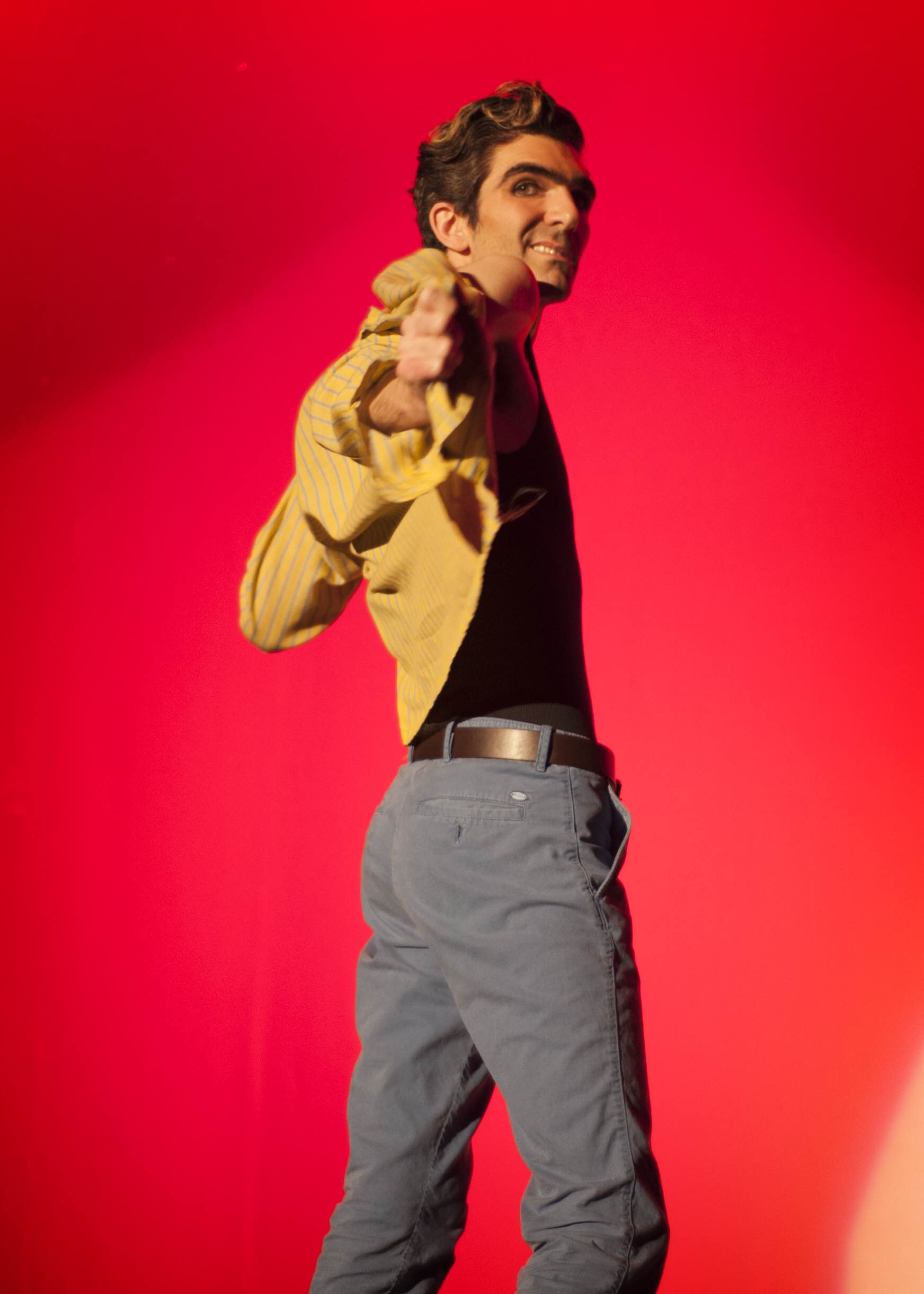
The post Interview: Recent Boylesque Graduates appeared first on Academy of Burlesque.
]]>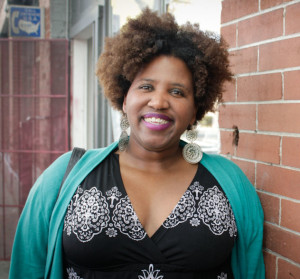
Reagan Jackson is a writer, artist, activist, international educator and award winning journalist. She’s been a regular contributor to the Seattle Globalist since 2013. Her self published works include two children’s books (Coco LaSwish: A Fish from a Different Rainbow and Coco LaSwish: When Rainbows Go Blue) and three collections of poetry (God, Hair, Love, and America, Love and Guatemala, and Summoning Unicorns). To find out more check her out at www.rejjarts.com
Last Fall Reagan Jackson, a reporter from Crosscut, took Burlesque 101 with The One The Only Inga. She wrote this incredible article about her experience that captures the journey of 101 so well.
See the original post on Crosscut here: http://features.crosscut.com/making-a-burlesque-dancer
The making of a burlesque dancer
What a Burlesque 101 class taught me about my body, beauty and friends who aren’t afraid to glitter your butt
I’m standing on a darkened stage in fishnets and heels with a rainbow fish windsock strapped to my ass, thinking that in 3 minutes and 12 seconds this will all be over. It’s time to go big or go home.
The curtains part and the music breaks. From behind a wooden screen decoupaged with green glittering reeds and blue tulle, I wave a single elbow-length black glove stitched with spiky gold fins. The crowd goes, ooooh.
I can’t believe I’m actually doing this. After an intense six weeks of Burlesque 101 with Seattle’s Academy of Burlesque, I’m making my stripper debut as Cocoa La Swish, a fish diva emerging from the reeds of self-doubt into the shiny confidence of my own bedazzled body.
I bite the air and smile.

So you want to be a stripper…
Six weeks earlier, I’d walked into the first night of our class at Studio Blue, a dance space on Rainier Avenue. The room resembled every other dance studio I’d ever been to. It had a hardwood floor with a wall of mirrors and an adjacent wall of cubbies separated by a curtain of pink fringe. A metal rack draped with feather boas reminded me that though I’d taken dance classes before, this would be a different experience.
Growing up, I learned early on that being black and beautiful meant being thin, having light skin and hair that hung straight and long with no kinks. Basically, the standard of beauty was being the whitest version of black, with occasional exceptions for those coal-black African models who were bone-thin and “exotic.” I’m none of the above.
After filling out some required paperwork, I took a seat at a table in the center of the room with an awkward smile and wave to my classmates.
“Hi, What’s your name?” asked the chipper brunette in fishnets and hot pants.
I answered and she introduced herself as Crystal.
“She’s like the Mayor of Burlesque class,” the man beside her explained, and I wondered when the elections had been held.
Looking around the table at the group of seven white women and one white man — the majority of them younger than me, and definitely in better shape — I wondered if they were mentally undressing me, too. I felt my insecurities begin to whisper.
A woman who called herself The One, The Only, Inga introduced herself as our Stripper Spirit Guide and Life Coach. If there were a casting call for a naughty Tinkerbell, Inga would fit the bill: petite but well-muscled, with short, chic blond hair. She told us she trained in jazz and modern dance for 16 years before attending her first burlesque show at the Rendezvous Dance Theater downtown and getting “the call” to perform. She toured the world as a member of the Atomic Bombshells, and was Miss Viva Las Vegas 2011.
Inga announced that the goal of the class was to turn us into “magical sparkly naked people” on stage. There was a round of introductions. Like Inga, several of my classmates talked about getting “the call.”
I felt my stomach fall. I had never thought of public nudity as an aspirational goal. I saw the Burlesque Nutcracker last Christmas. The costumes were lavish and the dance routines were so fun that when the opportunity to take the class for free arose, I thought, why not?
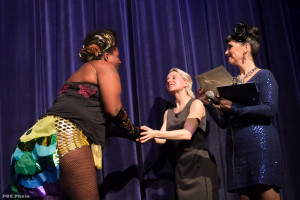
By the end of the first class, all the why nots showed up in stereo and danced in my head like hyper critical sugar plum fairies embodying the voices of every kid on the playground who ever called me fat, ugly or nappy.
“You can’t have your 10th performance until you’ve had your first performance,” Inga said, encouragingly.
What, exactly, is burlesque?
There was no dancing in our first class. Instead, Inga gave us a comprehensive history of burlesque.
Burlesque had its origins in Greek Theater circa 426 BC, then spread to the Romans, through the UK, and later to the U.S. What began as satire performed by men (call it Ancient Saturday Day Night Live) gradually integrated women in the late 1800s and evolved from sociopolitical commentary into chorus lines and strip teases.
We learned about Lydia Thompson and her British Blonds, whose six-month tour of the States turned into six years and gave birth to the concept of girls in tights doing chorus lines. Little Egypt caused a stir at the Chicago World’s Fair by performing the first recorded belly dancing in the United States.
For many years, strip acts were illegal in the U.S. except in New Orleans, so cunning dancers used to wear “nude” bathing suits. At one point, it became illegal to touch your own body in public, so strippers used puppets and trained birds to remove garments for them.
During the 1920s and ’30s, the New Orleans jazz scene provided a soundtrack to a racier version of burlesque, with more Creole and black women performing. Many white performers drew inspiration from women of other cultures — Little Egypt, for example, who was actually Syrian, but borrowed dance moves from Moroccan belly dancers — raising questions about cultural appropriation.
Inga was all about the business. It was a more thorough introduction than I had expected, but it made me feel grounded. I’ve always been an activist. Stripping for stripping’s sake felt overwhelming, but joining a legacy of woman who danced in ownership of their own bodies seemed like an accessible way for me to rationalize trying something new.
Cocoa La Swish is born
For homework, we had to create our stage personas. This part was easy. I named my alter ego years ago. I even wrote a children’s book about her called Coco La Swish: A fish from a Different Rainbow. Coco is a vibrant and vivacious fish who overcomes the jeering of hater fish to be her fabulous self. But how to take Coco and turn her into Cocoa?

More than just a name, I had to build my character’s backstory. Where was she from? What was her favorite drink? Her crush? Her favorite pick-up line? I decided Cocoa would be like Grace Jones combined with Godzilla and rolled in glitter — fierce and unapologetically bold.
When we met for our second class, my classmates and I re-introduced ourselves by our invented personas. The others had names like Scarlett Herrington, Muffy Thyme, and Ivy Thorny. There was Lana del Spray, creator of messes, Crystal D’Cummings, who arrived in the world on a magical flying unicorn to be a sex and life coach, and Kat Trick, a submissive, perennially heartbroken, small-town waitress whose super power was stripping.
Cleopatra of the South (who in real life is a civil war re-enactor from Alabama) based her character on Isabella “Belle” Maria Boyd a confederate spy from West Virginia. Perry Von Winkle, a gender fluid immortal, was born to a family of witches and raised like Samantha from Bewitched.
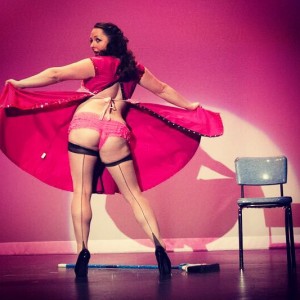
My mind pinwheeled out into questions: What is sexy and why? Who gets to decide? We like what we like and we know it when we see it, but how much of this is personal preference and how much is determined by cultural norms?
Becoming Cocoa was an invitation to enter a world of fantasy and play, and I was excited to try it out. I went home and narrowed down my song choices and began plotting my act. But reality kept interrupting my fantasy life. When I looked in the mirror, I didn’t see Cocoa, I only saw myself and the various intersecting identities that didn’t match up with any image I’d ever seen of a burlesque dancer.
Growing up, I learned early on that being black and beautiful meant being thin, having light skin and hair that hung straight and long with no kinks. Basically, the standard of beauty was being the whitest version of black, with occasional exceptions for those coal-black African models who were bone-thin and “exotic.”
I’m none of the above. I’m thick and tall with brown skin and an afro. It took me a long time to get over all the teasing I got as a kid and to embrace myself as beautiful. I had to work hard to undo all the negative programming.
Being big, black, and beautiful in this society is an act of courage, but I didn’t want it to be. I wanted, for once, to experience the privilege of assumed beauty, to feel sexy and confident without it being a political statement. Maybe that might have felt more attainable in a situation with different demographics, but as I visualized our recital, I felt like the token. Could I really do this? Did I even want to?
The big freak-out
Waxie Moon, a brilliant boylesque performer, was our guest instructor for week 3, the bump-and-grind week. It felt good to be on my feet and out of my head. We learned the art of the shimmy, and strutting in heels with and against the beat. Then we practiced teasingly removing our gloves.
Teasing is an art — what you show and what you don’t and how you invite an audience to get invested in what you’re willing to give. While I still hadn’t decided what I was willing to give, Waxie gave me some perspective. In sweatpants and heels with sculpted facial hair, he reminded me that outside-the-box could be a positive.
The evening culminated with each of us performing a sexy walk to a chair where we did three poses, a glove tease with a “deny” (that classic give-you-a-little-skin-then-take-it-back) and then the dance move of our choice. We wolf-whistled and cat-called as one by one we showed off our moves, and I realized I was actually having fun.
Then came week 4. Inga says that everyone freaks out in week 4. I freaked out. Even though I’d been keeping up on my homework and attending private lessons in addition to the regular classes, I still didn’t feel ready.
It occurred to me that this wasn’t some theoretical performance anymore. In two weeks I was going to go on stage and take my clothes off. Strangers were going to see and judge my body. Friends were going to see and judge my body. I was going to trip on my stripper heels, my boobs were going to come flying out of my gold beaded butterfly breast plate, my ass was going to explode out of my sequined hot pants, and I was going to literally die of embarrassment.
Inga assured me that I didn’t have to get totally naked. I could strip to pasties or even to a flesh-colored bathing suit if that’s what felt comfortable. Nothing about this experience was comfortable. I wanted to scream.

Over the weekend, I got sick, so I missed the optional tassel-twirling class, where all of my classmates took their tops off and became titty sisters. They were all BFFs afterwards, and though Lana del Spray invited me to come to class early to catch up on my boa work, I felt a little left out.
After the optional bump-and-grind class, Kat Trick, Cleopatra of the South, Muffy Thyme and I went on a costume shopping excursion. We had lunch first and it was nice to get to know them. Kat is a realtor. Cleo is the mother of 9 children, grandmother of 15, and has been doing burlesque back home in Alabama for a couple of years. She’s only here for a few months before she returns to the South. Muffy is a biologist and has been learning how to be an aerialist.
Though we all came from different walks of life and probably wouldn’t have met any other way, the class created our common ground. “We’re all nervous too,” Kat told me when I confessed that I was panicking. Just like everyone had their reason for being in the class, they also had their challenges too, and there was something comforting about knowing I wasn’t alone.
Practice runs
My heart raced as I made my grand entrance. Everyone was staring at me. I knew they would be, because that is what audiences do, (and what I had just done to six of my classmates) but I didn’t realize it would be so awkward.
I’d spent an afternoon painting and gluing glitter on reeds for my backdrop, but the costume still hadn’t come together. I wore black peep-toe heels, fishnets and a gold beaded backless halter shaped like a butterfly. A friend used her seam ripper to pop the hoop out of my rainbow fish windsock. Using safety pins and a length of fabric, I rigged up a tail.
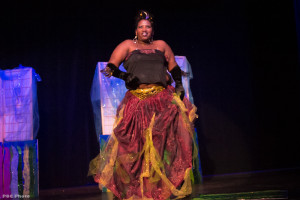
On top, I wanted to wear something elegant, a two-piece ball gown with full-length, black satin gloves. I’d found a beautiful wine-colored gown with a poofy skirt layered with lace, but it was still all in one piece, so I rolled down the ill-fitted bodice and wore a T-shirt. I felt disheveled and mismatched.
When the baseline hit, I rolled my body, giving life to my shimmy, but my tail snagged the back of my fishnets and my skirt kept slipping off my waist and got tangled under my heels. I tried to keep smiling, but I could see all the faces in the audience and it was freaking me out.
I took my skirt off and crawled on the floor, then stepped on my tail trying to get up. When I ripped my top off all I could think was, everyone is looking at my stretch marks. This was a new level of vulnerability, and I didn’t like it.
Winded and sweaty, I managed to sit politely through the remaining acts. Everyone seemed so much more together than I felt. Their costumes were complete, and their acts were sexy and hilarious. I kept trying not to compare myself, but when I went home, I sobbed. My performance was going to suck. After a month of working on it, I felt invested — I wanted to get on stage and kill it as Cocoa, but it felt impossible.
Two days later, I had my private lesson with Inga. I didn’t talk about my full-on meltdown. I admitted to not loving my run-through and Inga assured me it was great. We went over my floor work and she made me run through the routine again, making “Bugs Bunny porno faces.” It is impossible to mope and make stupid faces at the same time.
I came up with a new mantra: I’ll only be on stage for 3 minutes. I’m not going to die.
Then it was time for our second dress rehearsal. First up was Cleo, dressed as Maleficent and stripping to a love letter from Walt Disney. Her act had a classic feel to it and was sultry, funny and ended in tassel twirling. Then came Kat Trick, decked head-to-toe in Seahawks swag, attempting to get the attention of a man glued to the TV. Icy London played a ’50s housewife sick of cleaning. She had even bedazzled her broom. She went from Donna Reed to dominatrix.
Lana del Spray’s act took place in a kiddie pool, so we went outside. The burlesque studio shares a parking lot with a plumbing company, so one confused and embarrassed plumber caught the gaggle of us cheerleading Lana in various states of dress. Though it was freezing, Lana performed like a pro. Her act involved stripping out of rain gear. (Just a year ago she was engaged and living in a yurt on a pot farm. She gave all of that up to start a new life in a new city.)
She was supposed to end in a merkin and pasties with tassles, but I think the pasties came off in the kiddie pool. She kept twirling anyway.
We went back inside and Ivy Thorny played a naughty nurse resurrecting a dying patient with the power of her pussy. Then it was my turn.
Somehow, between contributions from four friends and several trips to thrift stores and fabric shops, I’d pieced together a workable costume. With my costume complete, steps and faces refined, I got through my routine — and it didn’t suck.
Muffy Thyme performed after me. She was a gender-bending rodeo cowboy/girl who stripped to the country version of “99 Problems and a Bitch Ain’t One,” while knife-throwing and dancing a two-step. The big finale was Perry Von Winkle, pizza stripper extraordinaire. Perry, a bank teller by day, pranced around light-footed in denim and red dance pumps with a pizza box before stripping to a pepperoni pizza leotard studded in rhinestones and trimmed with glittery cheesy fringe.
Maybe, just maybe, we were going to pull this off.

Go-big time
The day of the recital, even arriving four hours early, I felt rushed. I was up late the night before spray-painting my tailored prom skirt with blue and green glitter, and then sewing, pinning and tying it with green and gold ribbons. My fish tail was fluffed, my headdress was pinned and repined. Muffy tied me into my gold beaded butterfly bikini while Perry applied my fake lashes.
Somehow, even without having much time to get to know each other, we had become a community. When Lana handed me a brush and asked if I would glitter her butt, I didn’t hesitate. We zipped, tucked, snapped and strapped one another into our respective costumes, wolf whistled for each other during our dry runs, and kept each other in chocolate and bobby pins.
And then there I was, standing in the dark, listening to Indigo Blue introduce me. It was a reckoning, those final jittery moments. But in the midst of all that painting, sewing, music mapping, rehearsing and wrestling with my insecurities, I’d made a space in my life for whimsy and magic. And most importantly, I’d made a commitment to not be half-assed.
Spotlight on me, I shed my gloves, then touched my bare arms and shimmied from one side of the stage to the other. I turned around and began my skirt tease with a grin. When I dropped my skirt to reveal gold hot pants and my shiny rainbow fish tail, the audience erupted in laughter and applause. I tossed my skirt to the side, crawled center stage, struck a sexy pose, then belly-flopped and made fishy faces while I kicked my heels and swam.
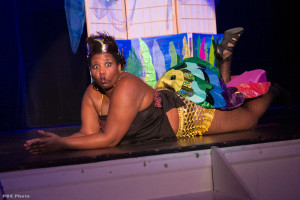
I got up and darted back behind the screens of reeds for one last tease. I dangled my top on one finger before tossing it aside. Then I emerged with my worm boa, in my gold beaded butterfly breastplate, to strike my triumphant final pose. For one moment, I stood confidently in my own skin. The crowd went wild.
In that moment, as the audience cheered, I realized how much I needed this experience. I realized that I’d needed to heal the parts of me that had internalized what media, kids at school, former lovers and even my parents have said about my body. I realized that I could choose to love and approve of myself exactly as I am — at this weight, this height, this physical incarnation. I didn’t have to be
Cocoa to shower myself in glitter and ribbons and to feel sexy, strong and confident.
Burlesque may not have felt like a calling at first, but I’d been called — and despite all my hesitations, I’d answered. And I’d found a community of really cool people who held space for me to do what turned out to be some pretty deep personal work. Through the process of shedding my clothes, I opened myself up to shedding my fears, insecurities and self-imposed limitations.
I don’t know if I’ll ever do it again, but I take with me the pride of knowing I was brave enough to try.
The post Article: “The Making of a Burlesque Dancer” appeared first on Academy of Burlesque.
]]>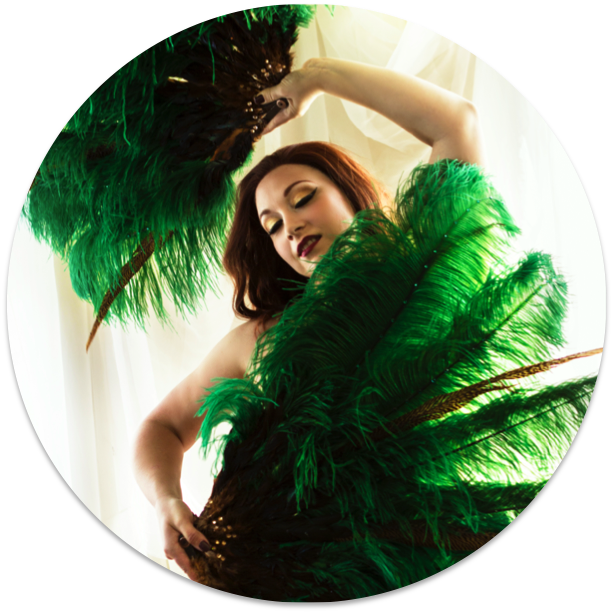
Our newest Teacher in Training, Amara Strutt, comes to us with a background in costume design, and here she talks about her creative process and some tips and tricks for costuming burlesque acts!
AOB: Where do you get inspiration for costumes?
Amara: My process in terms of act creation is music, and quickly followed by costume. I can’t do an act first and then figure out a costume. It’s really different from dancing, for example, where you dance, and then you find a thing that lets you move freely. Burlesque is about the tease of pulling your clothes off, so it depends heavily what your clothes are.
I do keep Pinterest boards, I think they’re very useful. I see things all the time and I get ideas,and it’s a way to organize those ideas and colors. I actually tend to shy away from a lot of colors in one act. Black, white and grey can show off texture more. I find contrasting textures very interesting. Sparkly is beautiful, but things have become so sparkly that there seems to be this fear of leaving anything unsparkled. I think the idea of a beautiful fabric, like a satin, by itself is really striking.
AOB: What is your process for creating a new piece?
Amara: I don’t always sketch my full ideas, but with some acts I have so many ideas that I have to sketch to organize.
I kind of stumbled on my sketching process. I found these templates online with figures and lines ready for sketching. I used the different views of them, printed all them out. And then took pencil and sketched them on there and figured out what I wanted, did the final lines and then scanned them in. I did one where I actually went a colored the whole thing in by hand like I did in the past. Then it was hard to change things, so out of curiosity I scanned it in and then in Photoshop I was able to do the final draft. Now I will always do it this way. Not only is it easy to go back a change a thing, but then I can share them digitally.
I’m more and more using made things that I can alter, rather than building something from scratch. Time is way more valuable than we seem to think it is, and way more scarce.
I start collecting the pieces that I need. I kept on my list app on my phone. I had lists of costume needs – all the little pieces I needed to collect on there. If I was in a store I could look that up and check them off.
I do as much shopping as I can at thrift store. Frequently you’ll find better materials, and it’s thinking outside the box. I get everything I can online – the rhinestones and everything. It’s so much cheaper and you need way more than you think.
And then while they’re in process I keep the materials for each costume organized in drawers.
AOB: What pearls of wisdom to have for eager costumers out there?
When you’re collecting materials, look at curtains! Especially tapestry, or chiffons, which are way cheaper. They’re already cut and hemmed, so if you’re making a panel skirt for example, you’re basically done.
Also, if you want to make a pattern, go to Goodwill and find something that fits you, then take it apart to copy for a pattern. But before you do that, cut it in half and keep one half in tact. That way if you get confused constructing your new garment you can go back and see how it all fits together.
Amara teaches our teaser classes and bachelorette parties.
The post Tips & Tricks: Costuming with Amara Strutt appeared first on Academy of Burlesque.
]]>
Jo with the cast of the 2014 Alumni invitational showcase.
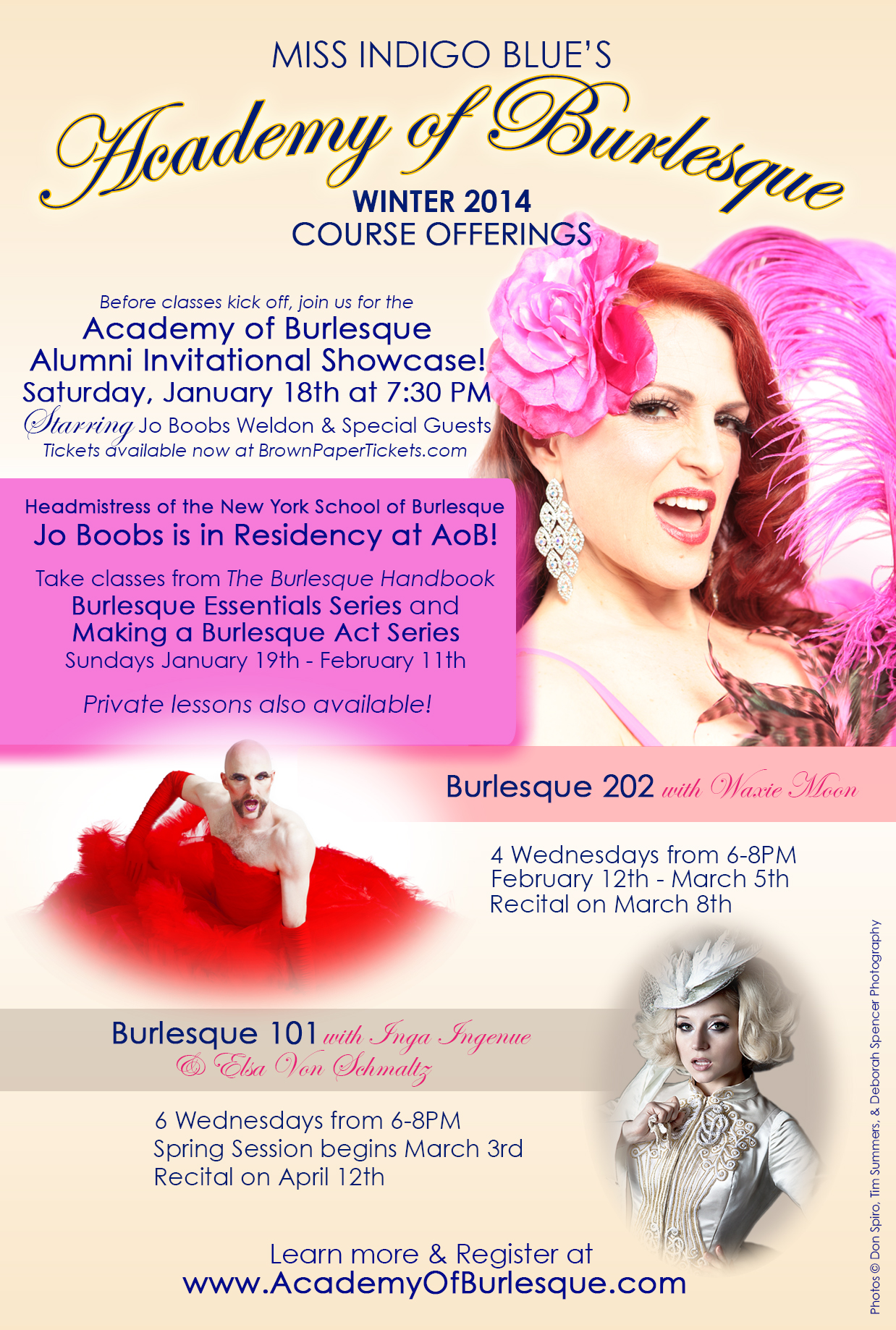
Looking Back: Jo “Boobs” Residency
Over the years the Academy of Burlesque has been proud to host a number of visiting guest instructors. We love bringing in talent from other parts of the country to cross-pollinate with our local performers and give our students a broad view of the world of burlesque. We asked Headmistress Miss Indigo Blue for some memories of when Jo “Boobs” was here in residency from New York.
In the winter of 2014, the Academy of Burlesque had the tremendous fortune of having the illustrious Jo “Boobs” Weldon as our Instructor-In-Residence. During the (very cold) month that she spent in Seattle, Jo taught two courses and performed in our Alumni Invitational Showcase.
Jo and I have worked together in many capacities over the years – and it has been an honor to have her as my colleague. We are the Co-Directors for Education at the Burlesque Hall of Fame, original Co-Curators of BurlyCon, and partner Headmistresses at our respective institutions across the continent from each other.
Twice she has traveled to the Northwest to Co-Teach with me at Burlesque Intensive Retreats. And uncountable times she has been my ear, and I hers, as we create this industry of Burlesque Education on the fly.
It was a wonderful treat to host her, and a delightful pleasure to have her teach here at the Academy of Burlesque.
The post Looking Back: Jo Weldon’s Residency at AOB appeared first on Academy of Burlesque.
]]>
Instructor Ruby Mimosa has been teaching at the Academy since 2007.

A number of Academy instructors perform with The Atomic Bombshells, one of Seattle’s best-known burlesque troupes.
A number of our instructors have performed with the The Atomic Bombshells, one of Seattle’s best known burlesque troupes. We caught up with Ruby Mimosa to talk to her about what it’s like performing with a troupe.
AOB: What are the pros and cons of performing with a burlesque troupe?
Ruby: One of the biggest pros of performing consistently with a troupe is having people to bounce ideas off of. Having the camaraderie of a group gives you a good basis for getting critique – you don’t need to find someone to help, they’re right there. There’s also a sense of oneness and togetherness; you’re all part of this funky burlesque gang. It’s also really nice to perform consistently with the same people. They get to know your music, and can help out if anything goes wrong on stage. In terms of cons, it can actually limit you to meeting other people. You already have a solid group, and you’re not performing with other people so you’re not meeting them. Some people may also feel intimidated to talk to you, since you’re this big group of people, and they’re not part of the group.
AOB: What is it like performing other people’s choreography?
Ruby: When you’re doing someone else’s choreography, it has to be exactly the same every time, especially if it’s a group number. When it’s your own stuff, you can have the freedom to improvise if you want to or if something goes wrong with your costume. Performing with other people in a group gives you this solid base and consistent look. The more people who have the same look, the better it it’s going to be, and that’s exciting.
AOB: What made you join the Atomic Bombshells?
Ruby: I moved to Seattle and very shortly saw them perform, I think it was January 2007. Dita Von Teese was with them, and seeing it I knew it was what I wanted to do. I grew up on classic musicals, and classic jazz and tap and showgirl-y things and loved that look. I’d also been fascinated by strippers, and it looked like a lot of fun. I ended up taking Bump&Grind with Indigo, and she really helped push me into the world of burlesque. When the Bombshells were looking for a new member, I auditioned and the rest is history!
AOB: What is it like to work so closely with a group of people?
Ruby: Like any group of people, there are personalities and group dynamics to keep in mind, and it takes patience and kindness. It helps to keep in mind how exciting and fun our lives are, and that we’re lucky to be doing this. Everybody has some sort of role in the group. I’m the person that wants everybody to get along. If something is challenging, I’m thinking about if I can fix it, or offer compassion? But really laughter is the best medicine in these situations, and getting to laugh about things helps a lot.
AOB: Can you tell us a story about your most recent tour?
Ruby: We were in Provincetown over the summer, and space in the theater is really tight! There are other shows happening in there, too, so we would have to be out 15 minutes after the show closed. We would work together to get into our costumes and to do quick changes, and would be packing up as we went. During that run, we lost a couple of costume pieces in the audience! A bra went into the crowd and never came back, and we had to remake it before the next show. Ruby Mimosa has been teaching at the Academy of Burlesque since 2007.
The post Interview: Ruby Mimosa appeared first on Academy of Burlesque.
]]>